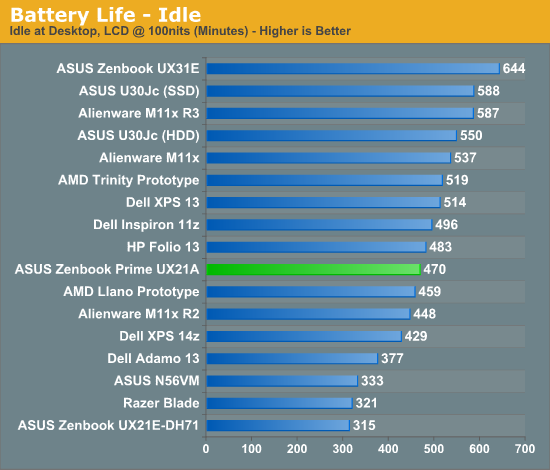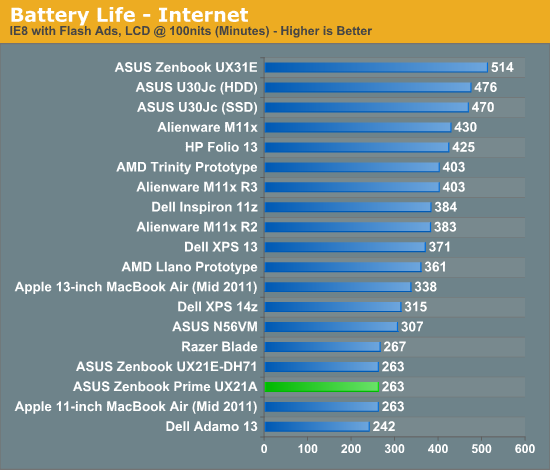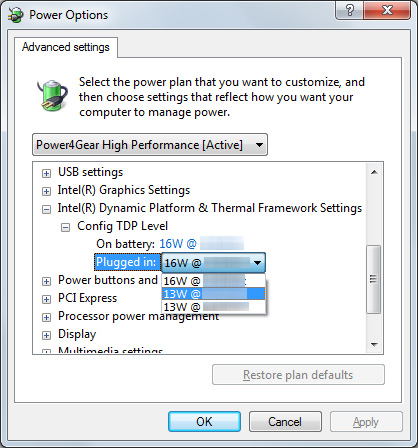ASUS Zenbook Prime (UX21A) Review: The First of the 2nd Gen Ultrabooks
by Anand Lal Shimpi on May 22, 2012 2:46 PM EST- Posted in
- Laptops
- CPUs
- Asus
- Ivy Bridge
- Zenbook
- Zenbook Prime
- Ultrabook
- Notebooks
Battery Life
Generally speaking, the 11-inch Zenbook Prime delivers about the same amount of battery life as its predecessor. For some reason we're able to hit much longer idle battery life on the Prime than the original Zenbook although I'm still trying to find out why. There's also an 11% improvement in our x264 playback test, but on average I'd expect to see similar battery life to the Sandy Bridge model - just with better performance. Note that these results also come despite the fact that ASUS is driving a much higher resolution, and presumably higher power, display than the original Zenbook.



The Zenbook Prime bucks the trend Jarred saw with the first Ivy Bridge notebook review where battery life took a small step backwards. These results bode well for future Ivy Bridge notebooks and Ultrabooks. It still remains to be seen if Intel's 22nm process will actually give us a battery life advantage in any notebook compared to its predecessor. It's possible that we are seeing some of the benefits of 22nm here already and they are simply offset by the more power hungry display. With the move to 22nm Intel should have a better hold on active power and leakage, but it's always possible that we'll have to wait until Haswell for the process to really be exploited.
Just like last time, ASUS has a couple of widgets to quickly change between power settings. The instant on widget lets you switch between suspend to RAM and suspend to disk modes. The former is expected to deliver up to 2 weeks of standby battery life, while the latter can push up to 150 days. I didn't have the time to test these claims (life is short, I draw the line at spending it testing claims of 150 day standby battery life). ASUS once again includes a counter that estimates how long your system will last in either mode based on current charge levels and power usage.
The next widget is a quick tool to let you switch between high performance and battery saver Power4Gear power profiles. You can customize these profiles via the Windows control panel, but it's nice to have a button on the desktop that lets you quickly switch between them.
Configurable TDP
One feature of Ivy Bridge that we haven't been able to test until now is configurable TDP. While most Ultrabook CPUs ship with a 17W TDP, that's mostly an arbitrary thermal/power rating. If an OEM wants to design a chassis that can only accept a 13W part it previously had to hope that Intel would make such a thing. Alternatively, the OEM could underclock/undervolt a 17W chip on their own and hope to mimic Intel's validation and deliver a 13W configuration of their own. The former requires that a significant number of OEMs demand the part, while the latter is just too risky for the larger OEMs (get too aggressive on the undervolting side and end up with a bunch of unstable systems). The solution Intel proposed with Ivy Bridge is configurable TDP. For Ultrabooks this means you can set a 17W part to 13W.

Currently the setting is hidden away in Windows 7's power management settings. Once again I've had to censor the clock speeds here due to Intel's Ultrabook embargo:
You can map the 13W settings to the battery saver profile and then, at the click of a button, have a 13W Zenbook Prime instead of a 17W model. The difference in performance isn't significant however:
| ASUS Zenbook Prime Configurable TDP Performance - Cinebench 11.5 (Multithreaded) | |||||||
| 16W - Max Freq | 13W - Mid Freq | 13W - Lowest Freq | |||||
| ASUS Zenbook Prime UX21A | 2.79 | 2.67 | 2.67 | ||||
I'm still running battery life tests to quantify the impact on power consumption, but it's conceptually a neat thing to see in action finally. I suspect configurable TDP is going to play a major role with Haswell and convertible/dockable Ultrabook-tablet hybrids.
Thermals and Noise
As with most high performance notebooks that are this thin, cooling is difficult. Under load the fans in the Zenbook Prime are definitely audible, but in general ASUS does a better job cooling everything inside the Zenbook Prime than Apple does in the MacBook Air. I suspect much of this boils down to how aggressive Apple is about keeping fan speed/noise down compared to ASUS' desire to maintain a certain temperature level inside the chassis.










192 Comments
View All Comments
1ceTr0n - Tuesday, May 22, 2012 - link
I just would really prefer having a dedicated onboard ethernet jack personally. I'm still torn of wether I REALLY need a laptop or ultra book even though I'm using my Galaxy Note for basic needsEnzoFX - Tuesday, May 22, 2012 - link
If your basic needs are met by a Note, then what would you actually need an ethernet jack for? I've found myself in the similar situations before, I think we usually are inclined to sort of opt for something more future-proof, or rather have something that we don't need, rather than not have it and need it. However, when everything is being toned down and thriving towards minimalism, this proves to be a little impractical. I find the thunderbolt on Mac's make a lot of sense around this regard however. A simple dongle gives you whatever port you actually need, without sacrificing minimalistic design.zanon - Tuesday, May 22, 2012 - link
Agreed. TB seems at best mildly useful on the majority of desktop machines, but when looking at Ultrabooks one can really start to see the applications of it. Honestly the video port choice is the oddest part of this whole system. VGA and HDMI are definitely not what I'd have expected from even a 1st gen ultrabook, let alone the second. Maybe their market research shows most people hooking these up to TVs or something, but it still feels like an odd choice. No TB is the main disappointment though, as it limits the functionality as more of a desktop replacement. I'd hoped with Cactus Ridge that'd start to become more widespread. Maybe in the fall.
MGSsancho - Tuesday, May 22, 2012 - link
TB requires extra silicon, board space, and costs. At least with Display-port we can create any video output we need. with TB you need an expensive cable, GPU of some sort, Physical interface to hdmi, dp, vga, etc and lastly that device would need its own power unless you can get the TB controller at the other end along with a gpu all under 30w then and only then could it be line powered. DP is awesome but is more than a simple interface.JMS3072 - Tuesday, May 22, 2012 - link
Thunderbolt uses a standard Mini-Display Port for the external interface, and a straight video signal can be adapted the same way a DP signal canMobiusStrip - Tuesday, May 22, 2012 - link
A DisplayPort-to-HDMI adapter is literally $4 and puny.There's really no excuse for the lack of Thunderbolt at this point. Let's move out of the '90s.
Mumrik - Tuesday, May 22, 2012 - link
I'll be the ass who points out that HDMI is from 2002.B3an - Tuesday, May 22, 2012 - link
But this is Micro HDMI which is from 2009. And it's likely HDMI 1.4 as well, which is again from 2009.Fleeb - Wednesday, May 23, 2012 - link
It's still HDMI.KingGheedora - Thursday, May 24, 2012 - link
Using the same logic: "well computers are from the 1950's. (or 60's, or whenever)